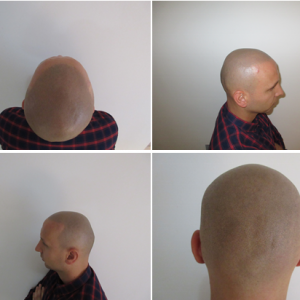
Scalp micropigmentation (SMP) is a relatively new, creative technique that some people are using to conceal hair loss and camouflage scalp scars. SMP is a tattoo applied to the scalp that mimics hair follicles cut close to the scalp.(1) This is generally done by using a stippling effect where differences in densities of ink create shading and the impression of texture. The results can be quite natural provided that the ink is added in an irregular pattern (vs. a straight line) and the pattern is in the direction of hair growth.(2) SMP is thought to be most effective for people with some hair coverage or in addition to hair transplants.(2) It may also be an option for people with no long-term solution for hair loss.(1)
SMP may be a preferred choice for people with many different conditions(1), including:
- Scalp scars or hair loss from scarring alopecias, alopecia areata, or alopecia totalis
- Women with thinning hair or balding that have not responded to minoxidil or other treatments and do not qualify for a hair transplantation
- Neurosurgery scars or scars from head trauma
- Complications from older hair restoration techniques that led to thin hair in donor areas or scarring
- Chemotherapy patients who do not grow back most of their hair following treatment
- People who do not want to use wigs or topical concealers
This technique has been used in 43 Korean patients without complications.(3) However, it should be cautioned that as with any procedure, there are potential risks. Universal risks with tattoos are infections and allergies, so it is important to use a trusted, experienced tattoo artist who follows proper hygienic procedures and outlines all risks. Often trusted tattoo artists performing SMP work alongside physicians. It is also important to use an experienced tattoo artist to avoid pigment bleeding from placing the pigment in the wrong depth of the scalp (i.e. dots become larger and unnatural looking).(1) Different areas of the scalp may also react differently to ink. For example, areas with hair loss generally have less blood flow and fat, and therefore retain pigment differently than hair-bearing areas of the scalp.(1) Over time, the colours will fade and most patients will need a touch-up every few years.(2)
Tattoos have become more popular and are becoming more socially acceptable. However, it should be recognized that SMP is a permanent concealer that is performed using an artist; therefore, every person will have a different experience. These procedures are generally long (up to 8 hours) and occur over multiple sessions. As this is a relatively new technique, it is important to consult with your doctor before visiting a tattoo artist to set realistic expectations.
Article by: M.A. MacLeod, MSc., Mediprobe Research Inc.
References
- Rassman WR, Pak JP, Kim J, Estrin NF. Scalp micropigmentation: a concealer for hair and scalp deformities. J Clin Aesthetic Dermatol. 2015 Mar;8(3):35–42.
- Lampeter W. Editor’s invited commentary: Micropigmentation: camouflaging scalp alopecia and scars in Korean patients. Aesthetic Plast Surg. 2014 Feb;38(1):205–6.
- Park JH, Moh JS, Lee SY, You SH. Micropigmentation: camouflaging scalp alopecia and scars in Korean patients. Aesthetic Plast Surg. 2014 Feb;38(1):199–204.












